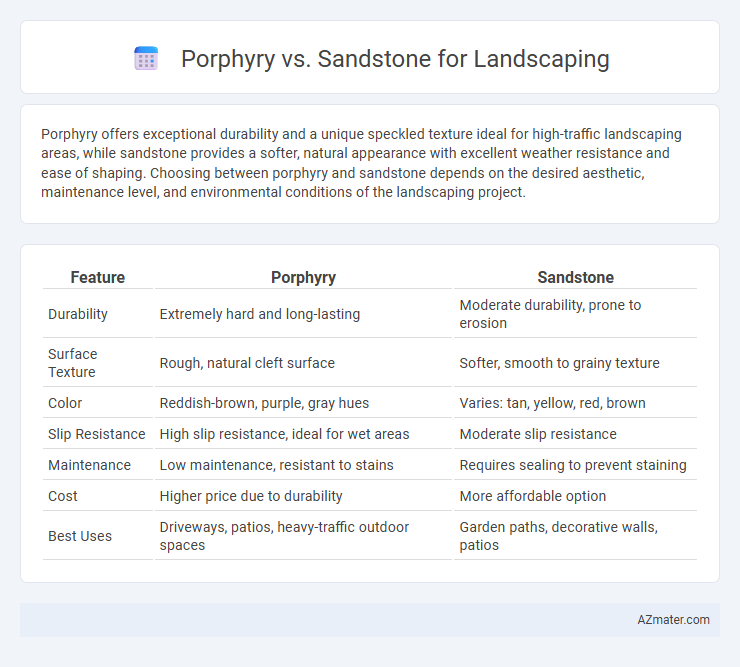Porphyry offers exceptional durability and a unique speckled texture ideal for high-traffic landscaping areas, while sandstone provides a softer, natural appearance with excellent weather resistance and ease of shaping. Choosing between porphyry and sandstone depends on the desired aesthetic, maintenance level, and environmental conditions of the landscaping project.
Table of Comparison
| Feature | Porphyry | Sandstone |
|---|---|---|
| Durability | Extremely hard and long-lasting | Moderate durability, prone to erosion |
| Surface Texture | Rough, natural cleft surface | Softer, smooth to grainy texture |
| Color | Reddish-brown, purple, gray hues | Varies: tan, yellow, red, brown |
| Slip Resistance | High slip resistance, ideal for wet areas | Moderate slip resistance |
| Maintenance | Low maintenance, resistant to stains | Requires sealing to prevent staining |
| Cost | Higher price due to durability | More affordable option |
| Best Uses | Driveways, patios, heavy-traffic outdoor spaces | Garden paths, decorative walls, patios |
Introduction to Porphyry and Sandstone in Landscaping
Porphyry is a durable igneous rock featuring a distinctive coarse-grained texture with large, visible crystals, making it highly sought after for landscaping due to its strength and aesthetic appeal. Sandstone, a sedimentary rock composed mainly of sand-sized mineral particles, offers a softer, more natural look with excellent workability and color variation ideal for creating warm, inviting outdoor spaces. Both materials serve unique landscaping purposes, with porphyry excelling in high-traffic areas requiring durability and sandstone preferred for decorative elements and pathways.
Geological Origins and Properties
Porphyry originates from volcanic activity, characterized by large, well-formed crystals embedded in a fine-grained matrix, offering exceptional durability and a unique, decorative appearance ideal for landscaping. Sandstone, formed from compacted sand grains over millions of years through sedimentary processes, provides a softer texture and excellent porosity, promoting natural drainage and weather resistance in outdoor settings. Both stones' geological origins influence their hardness and aesthetic, with porphyry being more resistant to wear and sandstone favored for its natural, earthy tones.
Color and Aesthetic Differences
Porphyry features vibrant reds, purples, and deep browns with a distinctive crystalline texture, creating a striking and luxurious appearance for landscaping projects. Sandstone offers a softer palette ranging from beige and tan to rusty reds, characterized by a smooth, grainy surface that brings a natural, earthy warmth to outdoor spaces. The choice between Porphyry's bold, polished look and Sandstone's subtle, muted tones depends on the desired aesthetic impact and the surrounding environment.
Durability and Weather Resistance
Porphyry exhibits exceptional durability and superior weather resistance compared to sandstone, making it ideal for high-traffic landscaping areas. Its dense, igneous composition withstands harsh environmental conditions without significant erosion or color fading. Sandstone, though aesthetically appealing, is more porous and susceptible to weathering, requiring additional sealing to enhance its longevity in outdoor applications.
Maintenance Requirements
Porphyry requires minimal maintenance due to its natural hardness and resistance to weathering, making it ideal for high-traffic landscaping areas. Sandstone, being softer and more porous, demands more frequent sealing and careful cleaning to prevent staining and erosion. Regular upkeep for sandstone includes protective treatments to maintain its aesthetic appeal and structural integrity over time.
Slip Resistance and Safety
Porphyry offers superior slip resistance due to its natural rough texture and high durability, making it an ideal choice for landscaping areas prone to wet conditions. Sandstone, while aesthetically pleasing, tends to become slippery when wet unless treated with anti-slip coatings or textured finishes. Prioritizing porphyry enhances safety in walkways, patios, and pool surrounds, reducing the risk of slips and falls in outdoor environments.
Environmental Impact
Porphyry offers a sustainable landscaping option due to its durability and low maintenance requirements, reducing the need for frequent replacements and minimizing resource consumption. Sandstone, while aesthetically pleasing, tends to be softer and less durable, leading to faster erosion and increased environmental disturbance through more frequent quarrying. Choosing porphyry over sandstone can significantly lower the ecological footprint by preserving natural resources and decreasing long-term environmental degradation.
Cost Comparison
Porphyry generally has a higher upfront cost than sandstone due to its durability, unique texture, and extraction complexity. Sandstone offers a more budget-friendly option with moderate strength and easier sourcing, making it popular for large-scale landscaping projects. Long-term maintenance costs favor porphyry because of its resistance to weathering and lower replacement frequency, balancing the initial investment over time.
Installation Techniques
Porphyry installation involves precise cutting and interlocking of the igneous volcanic rock to create durable, aesthetically polished surfaces ideal for pathways and patios. In contrast, sandstone, a sedimentary rock, requires careful leveling and compaction of the base due to its softer texture, ensuring stability and drainage for outdoor landscaping applications. Both materials benefit from using mortar or sand joints for proper setting, but porphyry's hardness allows for thinner joints and less maintenance over time.
Choosing the Right Stone for Your Landscape
Porphyry offers exceptional durability and a distinctive reddish hue that enhances outdoor landscapes with natural elegance, making it ideal for high-traffic areas such as patios and pathways. Sandstone features a softer texture and warm earthy tones, providing a more rustic and inviting appearance suitable for garden edging and decorative accents. Selecting between porphyry and sandstone depends on factors like weather resistance, maintenance requirements, and the desired aesthetic impact in your landscape design.

Infographic: Porphyry vs Sandstone for Landscaping
 azmater.com
azmater.com